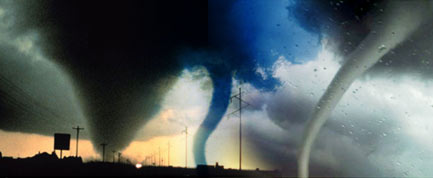Forecast: More Killer Tornadoes Strike at Night

Tornado warning systems have decreased deaths in the United States resulting from these destructive storms, but the alerts might be leaving us vulnerable to twisters that strike at night, a scientist now warns.
In the past century, tornado deaths have declined overall, in large part due to sophisticated forecasting technology and warning systems that give people in the path of a storm time to get to safety.
But a new study by Northern Illinois University found that the nighttime tornado death rate in the past 100 years hasn't kept pace with the decline in the rate for daytime tornadoes.
"The proportion of nocturnal fatalities and killer tornado events has increased during the last half century," said lead author of the study Walker Ashley, an NIU meteorologist. "Unfortunately, this nocturnal fatality rate appears to be a major factor for the stalled decline in national tornado-fatality tallies during the past few decades."
Population patterns
The study, detailed in the October issue of the American Meteorological Society's journal Weather and Forecasting, found that from 1950 to 2005, 27 percent of tornadoes in the United States were nocturnal, yet 39 percent of tornado fatalities and 42 percent of killer tornado events occurred at night.
Ashley predicts that annual tornado fatalities might begin to rise; in fact, they already have. In 2007 alone, 80 tornado fatalities were recorded, with 59 of those fatalities occurring between sunset and sunrise. Nineteen of 26 killer tornadoes that year occurred at night. So far this year, 123 tornado fatalities already have been recorded — nearly double the annual average.
Get the world’s most fascinating discoveries delivered straight to your inbox.
"The tornado death rate has bottomed out and is probably going to increase due to several factors," Ashley said. "Because of population growth and development patterns, including urban sprawl, tornado risk to the populace has increased in recent decades. Tornadoes are impacting larger populations that are more spread out, resulting in higher tornado death tallies."
Nighttime factors
The most dangerous window of time for a tornado, according to the study findings, is the period from midnight to sunrise. Tornadoes during this time period are 2.5 times as likely to kill as those occurring during the daytime hours.
People are more vulnerable during nighttime events, because:
- Tornadoes are difficult for the public and trained spotters to see.
- People are more likely to be asleep.
- People are more likely to be in structures that are more susceptible to damage, such as single-family homes and mobile or manufactured homes as opposed to schools and large office or workplace buildings. (Nearly 61 percent of tornado fatalities in mobile homes take place at night.)
- Warning sirens are designed to mitigate hazards for people outdoors and are less effective at reaching those indoors.
"Because most people go to bed after the late evening news, they are sleeping and unaware of televised weather alerts," Ashley said. "And warning sirens give us a false sense of security. They’re not designed for warning people who are already indoors. We’re not seeing a forecasting problem but rather a communication breakdown."
Ashley said that the best overnight warning option right now is a weather radio, though a relatively small proportion of Americans actually own one.
The mid-South region of the United States, which includes parts of Arkansas, Tennessee, Alabama and Mississippi, is most susceptible to nighttime tornadoes. The reasons for this susceptibility include a higher percentage of mobile homes in the region and seasonal factors.
More nocturnal fatalities from tornadoes occur between November and April, even though it is not during the peak tornado season. The switch from daylight saving time to standard time keeps daylight hours to a minimum during this period and because it is not during the peak season, storms can often catch people off guard.
- Video – Tornado Chasers
- Images: Tornado Country
- Top 10 Killer Tornadoes



